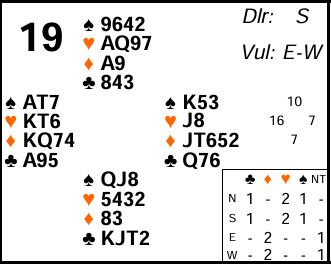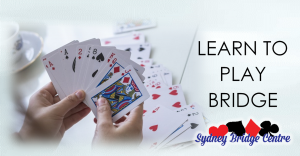City and Canada Bay – Thursday Morning 6th March 2025.

Board 19 last week will most likely have a simple auction of Pass, 1NT (15-17) all pass. How many tricks it will make depends a lot on North’s lead. A large majority of the field led ♥7. Is that such a good idea though? Let’s have a closer look.
Opening leads are the hardest part of bridge as you have the least information to go on – you haven’t seen dummy yet, so you only have the auction to guide you. No matter how brilliant a player you are, you will still frequently make a lead that gives a trick or the contract away!
We are usually taught to lead 4th highest from our longest and strongest suit against no-trumps as that frequently is the best chance to set up tricks in that suit to score later in the defence. ♥7 certainly fits that mould. But let’s see what happens here.
Declarer’s ♥8 in dummy will win the trick. He will of course immediately play on diamonds to knock out ♦A to set up 4 winners in the suit. Once North wins ♦A what next? It’s already too late really but he knows from South’s inability to beat ♥8 at trick 1 that declarer must have at least ♥K10 left so a 2nd heart will just give another trick away. He might try a black card but declarer by now has 2 spades, 1 heart, 4 diamonds and 1 club for 8 tricks. He might scrape a 9th trick as well if the defence get their discards wrong on the diamonds.
Things would go much better for the defence on a spade lead. That would run to the ♠J and ♠A. After winning ♦A, North can lead a 2nd spade. That helps set up a spade trick for South (and the 13th spade for North) and limits declarer to 2 spades, 4 diamonds and 1 club (North can win ♥Q and switch to clubs). Scoring -90 instead of -120 or -150 makes a huge difference.
Is that ♥7 lead unlucky? Possibly. On another day South might have had ♥K. But there are good reasons for North to consider a more passive lead. Here’s 3:
1. You are leading round to a known strong hand – so there’s a fair chance that the ♥K will be on your right and you’ve given a cheap trick away.
2. You only have 4 hearts. So you don’t have that many long cards in the suit to set up. If you had 5 hearts there would be more upside in giving a trick to the ♥K early on and it may help you establish 2 or 3 later winners.
3. You are playing matchpoint pairs. There’s more about this in the Advanced section but in general it means you want to avoid trying to give cheap tricks away – i.e. it favours being more passive.
The two possible passive leads on this hand are spades and clubs. A club will also work well on this hand but in general I’d far prefer a spade (see advanced section for why).
If you do lead a spade, which one? The ♠6 would be my choice. A common method is to lead the 2nd from a poor suit rather than the 4th highest. See advanced section for more on why – and what you should generally then play next.
Key points to note
Opening leads are tough – don’t be disheartened if you seem to give tricks away a lot. So does everyone!
Prefer passive leads when you sit over a known strong hand, especially at matchpoint scoring.
Prefer a major to a minor when leading passively against 1NT with no other information to go on.
The opponents’ auction and your own knowledge of how their suits are breaking can sometimes guide whether active or passive defence is more likely to be right.
More advanced
The scoring of matchpoint pairs is what makes the difference in lead strategy. At pairs you score points for HOW many other pairs you beat, regardless of how much you beat them by. That’s why a single overtrick can be worth a fortune at matchpoints but is almost irrelevant at imps. It’s therefore why you want to try and avoid giving cheap tricks away because there’s more to lose by doing so. At imps it’s different – your fundamental aim is just to beat the contract and you just want to lead what you think gives the best chance of doing that – if you’re wrong it doesn’t much matter if declarer makes an overtrick or not.
If I was making a passive lead on this hand against 1NT I would far prefer a spade to a club for several reasons:
1. I have 4 spades and only 3 clubs so there’s more chance the defence have more spades.
2. There’s almost no chance that dummy will have 5 spades (he didn’t transfer over 1NT) whereas he could certainly have 5 clubs (with which he’d still pass 1NT).
3. There are some weak hands with majors where LHO might have bid stayman. The fact he hasn’t done that reduces the chances he has major suit holdings.
If you do lead a spade I’d lead the ♠6 (2nd highest). A useful leading method is “4th & 2nd” which basically means 4th highest from long suits with at least one honour, and 2nd highest from a bad suit. The idea of leading 2nd is that partner may be able to work out from the cards he can see that your lead cannot be 4th highest (but note that’s not always possible and from a holding like 7432 you might consider leading the 7 not the 4 to make it easier for partner to read). That will help him place the honours in the suit. Traditionally you should then follow up by playing the 3rd highest on the 2nd round. That’s mainly to distinguish it from a MUD (middle up down) lead that you would make from 3 small. But also by playing 2nd then 3rd it means both your highest and lowest cards are missing from partner’s perspective. That hopefully will help him work out you started with 4 and not 2.
One little aside – I said 4th highest from a suit with an honour. But what’s an honour? A,K,Q,J definitely but what about the 10 for these purposes? That’s often a matter of partnership agreement. But it can make quite a difference both to the card you do lead and how partner might interpret your lead. Say you had a holding of 10852. If your partnership agrees that the 10 is an honour you should lead the 2; if it’s not you should lead the 8. Personally I prefer to NOT regard the 10 as an honour for these purposes – the general philosophy of doing so is you are saying to partner you are happy for him to return the suit if he gets in. With a higher honour that’s usually OK – but with only the 10 it might not be.
Overall in bridge there’s often a decision to make in defence about whether to be “active” (lead away from honours to attack in the hope partner has the right cards to help you) or “passive” (don’t lead away from honours and just sit back and wait for declarer to go off!). It’s frequently a very tough decision but there are sometimes clues from the auction or your own hand.
For example the following should point you to going passive:
1. The opponents have had an invitational auction and perhaps then stopped. (They won’t have extra values so don’t give them a cheap trick.)
2. You know that at least one the suits they have bid is breaking badly for them. (The contract could already be in trouble – unless you give them a cheap trick somewhere else!)
3. You are leading round to a known strong hand. (Better to wait and score your honours sitting over declarer’s.)
Conversely the following should point you to being more “active”:
1. The opponents have had an auction suggesting they were looking for slam but stopped. (They’ll have extra values so will be able to set up more winners – hence you need to establish your tricks quickly).
2. Dummy will be going down with a decent side suit. (Once set up it will provide discards for declarer’s losers so you need to get your tricks set up quickly before that happens).
3. You know that trumps or a key side suit are going to break well for declarer. (Same as 2).
Julian Foster (many times NSW representative) ♣♦♥♠




